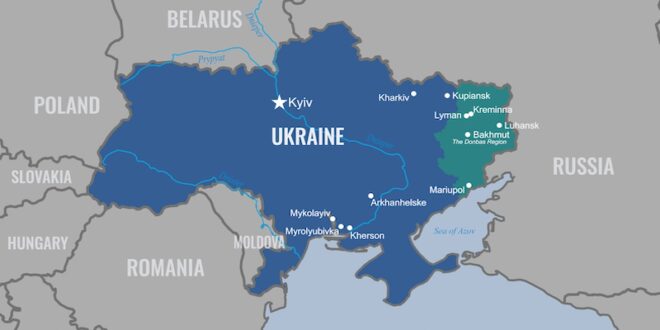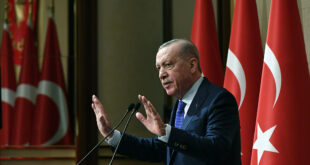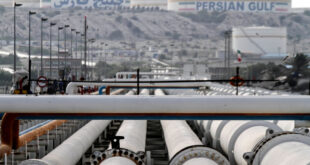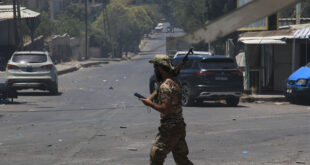Along the northern flank of Ukrainian-controlled territory on the outskirts of the eastern city of Bakhmut, tank crews from the 10th Mountain Assault Brigade are waiting for the ground to dry up so they can begin a long-anticipated counteroffensive against Russian forces.
The tank operators continue to support Ukrainian infantry during battles and provide cover fire from afar, but the muddy roads brought by thawed frozen ground and heavy spring rainfall have left them playing a less forward-leaning role.
“The Russians still have enough artillery and anti-tank weapons, including ATGMs [anti-tank guided missiles],” Mykola, a tank operator, told Current Time, following Ukrainian military protocol of only providing his first name to journalists. “We still have far from an easy time here and while it’s raining like it is now, it’s difficult to work.”
The battle for Bakhmut, which Russia sees as a stepping stone to other cities in Ukraine’s eastern Donbas region, has been the scene of the war’s most intense fighting for months, costing thousands of lives on both sides. Ukrainian forces have been pushed back in recent weeks, but have managed to keep some control of the area while inflicting as many losses as possible on regular Russian troops and fighters from the Wagner mercenary group.
Despite many military experts disputing its strategic value, Ukrainian officials have underlined the importance that Kyiv attaches to holding Bakhmut as Ukraine makes the final preparations for its expected counteroffensive, which will be backed by thousands of Western-donated armored vehicles – including tanks – and freshly trained troops.
When, where, and how Kyiv launches its push are crucial questions that Ukrainian officials have kept closely guarded. Analysts say the counteroffensive will have far-ranging consequences for the future direction of the war and the degree of its success could impact the level of Western support moving forward.
Among the tank crews stationed along the front with Bakhmut, attention remains fixed on the nearby battle that has become the epicenter of the war. Fighting in the area has been divided into two theaters: street combat inside the city and more distanced engagements in fields and villages to the northwest and southwest, where Russian forces are trying to encircle Ukrainian soldiers.
Petro, a tank operator in the 10th Mountain Assault Brigade, says that fighting has slowed down in their area in the northwest recently as clashes in the city have intensified with the Ukrainian military reporting the arrival of fresh Russian reinforcements.
“Fighting in Bakhmut drew away a very huge [Russian] force from [this area], and now it’s much quieter as the intensity is not the same,” Petro told Current Time, a Russian-language network run by RFE/RL in cooperation with VOA.
Many of the tank crews say Russian defenses are more dug in than they were during the early stages of the war and Petro says that combat is becoming more and more like “trench warfare.” Still, the tank operators say they are prepared to break through Russian lines and eagerly awaiting the looming counteroffensive.
“I would very much like to meet with their tankers, [but] it doesn’t matter if the tankers are there or the infantry,” said Mykola. “They need to be driven out of here!”
A Victory Day Push In Bakhmut
Ukrainian officials have said that the intensified fighting in Bakhmut is part of a Russian effort to capture the city by May 9, the date when Moscow celebrates its World War II Victory Day. Russia is sending in reinforcements, including additional numbers of Wagner mercenaries and Russian paratroopers, according to Ukrainian Deputy Defense Minister Hanna Malyar.
Ukrainian soldiers have faced a blend of Russian troops and Wagner fighters for some time in Bakhmut, with the mercenary group increasingly turning to prisoners to fill its ranks. Those convicts have suffered heavy casualties and been sent in waves in risky assaults as part of a tactic meant to wear down Ukrainian defenses for subsequent attacks by more skilled Russian forces.
The statement from Malyar appears to be at odds with a May 5 announcement by Wagner chief Yevgeny Prigozhin that he would withdraw his forces from the city on May 10 because of insufficient ammunition.
In a tense and profanity-laced announcement, Prigozhin said his forces had no choice but to withdraw to rear bases to “lick the wounds” in what appears to be the latest episode in an escalating feud between the mercenary group and the Russian Defense Ministry.
In his latest comments on May 7, Prigozhin did not specifically say he was reversing his plans to pull his forces from the city but said he had been given permission to “act in Bakhmut as we see fit.”
It remains to be seen whether Prigozhin actually does withdraw Wagner forces, but the move could jeopardize Moscow’s push to claim Bakhmut and reshape the battle in the process, even if rotations of regular Russian soldiers replaced Wagner forces on the front lines.
The grinding battle in Bakhmut has led to high casualties for both Russian and Ukrainian forces. The White House said on May 1 that Russia has suffered 100,000 casualties since December, including 20,000 troops killed in action. U.S. officials believe that many of those casualties have occurred in Bakhmut.
“By throwing its own forces into Bakhmut, Ukraine has tied up a large proportion of the Russian military, inflicting heavy losses,” Matthew Sussex, a military expert at Australian National University, wrote in a May 3 analysis of the eastern front. “Its approach is both a strategy of corrosion — the gradual attrition of the invader — and absorption, soaking up repeated Russian assaults while taking the pressure off other parts of the conflict zone.”
It’s unclear how many casualties Ukrainian troops have suffered in that same span. Kyiv keeps those numbers a secret and the U.S. government has refused to disclose similar estimates on Ukraine’s losses.
U.S. intelligence documents from late-February allegedly leaked by National Guard airman Jack Teixeira on the Discord platform indicated that up to 17,000 Ukrainian soldiers had been killed in action since Russia’s full-scale invasion in February 2022. The leaked intelligence assessment also said that as many as 42,500 Russian troops had been killed during the war’s first year.
Waiting For The Counteroffensive
While Bakhmut continues to be a focal point of the war, Russian occupation authorities ordered nearly 70,000 civilians living near the front line in southern Ukraine’s Zaporizhzhya region to leave their homes and businesses on May 5.
Ukrainian authorities have also implemented a curfew in the frontline city of Kherson for the long weekend’s Victory Day holidays, while some residents were seen leaving in cars and buses on May 5.
Together, the moves are additional indicators that Ukraine’s counteroffensive is approaching, analysts and officials say.
Strikes on Russian infrastructure, including drone attacks on refineries and train sabotage, have multiplied in recent weeks, and are also seen as part of Ukrainian preparations for a spring offensive intended to target Russian Army supply chains in border regions and in Crimea, which was illegally annexed by Moscow in 2014.
Kyiv has not claimed any of the acts, including a May 3 alleged drone attack on the Kremlin that Russian officials say was meant to target President Vladimir Putin. Russia accused Ukraine and the United States of involvement. Both countries have strongly denied any role in the incident.
Aslan Ocherkhadzhiev, a ethnic Chechen volunteer soldier fighting with Ukrainian forces in Bakhmut, told RFE/RL’s North Caucasus Service that fighting there remains intense, with Russian shelling increasing and their artillery apparently well-stocked in the city.
He says that Ukrainian forces will continue to engage with Russian troops in Bakhmut, but that in order to shift momentum, the Ukrainian side needs more long-range artillery in the area.
After months of tough winter fighting in Bakhmut, Ocherkhadzhiev adds that many soldiers are talking about Kyiv’s approaching counteroffensive and that he and others are eagerly watching for the ground to dry up so that Ukraine can begin its push against Russian forces.
“The ground will dry up and the armored units, along with the infantry, need to go on a counteroffensive,” Ocherkhadzhiev said. “The whole army must move forward.”
 Eurasia Press & News
Eurasia Press & News




